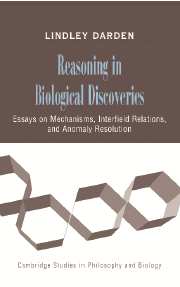 Reasoning in Biological Discoveries
Reasoning in Biological Discoveries Book contents
- Frontmatter
- Contents
- Long Contents
- List of Figures
- List of Tables
- Acknowledgments
- Introduction
- PART I BIOLOGICAL MECHANISMS
- PART II REASONING STRATEGIES: RELATING FIELDS, RESOLVING ANOMALIES
- 5 Interfield Theories with Nancy Maull
- 6 Theory Construction in Genetics
- 7 Relations Among Fields in the Evolutionary Synthesis
- 8 Selection Type Theories with Joseph A. Cain
- 9 Strategies for Anomaly Resolution: Diagnosis and Redesign
- 10 Exemplars, Abstractions, and Anomalies: Representations and Theory Change in Mendelian and Molecular Genetics
- 11 Strategies for Anomaly Resolution in the Case of Adaptive Mutation
- PART III DISCOVERING MECHANISMS: CONSTRUCTION, EVALUATION, REVISION
- Bibliography
- Index
- References
5 - Interfield Theories with Nancy Maull
Published online by Cambridge University Press: 31 August 2009
- Frontmatter
- Contents
- Long Contents
- List of Figures
- List of Tables
- Acknowledgments
- Introduction
- PART I BIOLOGICAL MECHANISMS
- PART II REASONING STRATEGIES: RELATING FIELDS, RESOLVING ANOMALIES
- 5 Interfield Theories with Nancy Maull
- 6 Theory Construction in Genetics
- 7 Relations Among Fields in the Evolutionary Synthesis
- 8 Selection Type Theories with Joseph A. Cain
- 9 Strategies for Anomaly Resolution: Diagnosis and Redesign
- 10 Exemplars, Abstractions, and Anomalies: Representations and Theory Change in Mendelian and Molecular Genetics
- 11 Strategies for Anomaly Resolution in the Case of Adaptive Mutation
- PART III DISCOVERING MECHANISMS: CONSTRUCTION, EVALUATION, REVISION
- Bibliography
- Index
- References
Summary
INTRODUCTION
Interactions between different areas or branches or fields of science have often been obscured by current emphasis on the relations between different scientific theories. Although some philosophers have indicated that different branches may be related, the actual focus has been on the relations between theories within the branches. For example, Ernest Nagel has discussed the reduction of one branch of science to another (1961, Ch. 11). But the relation that Nagel describes is really nothing more than the derivational reduction of the theory or experimental law of one branch of science to the theory of another branch.
We, in contrast to Nagel, are interested in the interrelations between the areas of science that we call fields. For example, cytology, genetics, and biochemistry are more naturally called fields than theories. Fields may have theories within them, such as the classical theory of the gene in genetics; such theories we call intrafield theories. In addition, and more important for our purposes here, interrelations between fields may be established via interfield theories. For example, the fields of genetics and cytology are related via the chromosome theory of Mendelian heredity. The existence of such interfield theories has been obscured by analyses such as Nagel's that erroneously conflate theories and fields and see interrelations as derivational reductions.
The purpose of this chapter is, first, to draw the distinction between field and intrafield theory, and, then, more importantly, to discuss the generation of heretofore unrecognized interfield theories and their functions in relating two fields.
- Type
- Chapter
- Information
- Reasoning in Biological DiscoveriesEssays on Mechanisms, Interfield Relations, and Anomaly Resolution, pp. 127 - 148Publisher: Cambridge University PressPrint publication year: 2006


